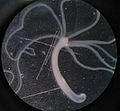
Guppies and water fleas live only days or weeks, but their mortality increases sharply with age, as is the case in longer-lived animals such as humans. But other animals — such as the hermit crab, the red abalone and the hydra, a microscopic freshwater animal that can live centuries — buck that trend, enjoying near constant levels of fertility and mortality.
A comparison of standardized demographic patterns across 46 species, published today in Nature, suggests that the vast diversity of ‘ageing strategies’ among them challenges the notion that evolution inevitably leads to senescence, or deterioration of mortality and fertility, with age, says Owen Jones, a biologist at the University of Southern Denmark in Odense, who led the study.
…
The authors suggest that the diversity of ageing strategies across the spectrum should challenge theoreticians. “The [evolutionary] theories we have are applicable in lots of situations — but they can’t explain some cases,” says Jones. “It’s not about throwing out old theories; it’s about modifying theories to work on all species.”
Critics reacted defensively, of course. What’s obvious is that we don’t know nearly enough to make “laws” that work for all species Remember, we can’t even We can’t even define life.
Pond hydra is long-lived? Yes, very.